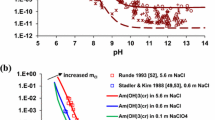Abstract
The speciation and distribution of Gd(III) in human interstitial fluid was studied by computer simulation. The results show that at the background concentration, all the Gd(III) species are soluble and no precipitates appear. However as the total concentration of Gd(III) rises above 2.610 × 10−9 mol/l,the insoluble species become predominant. GdPO4 is formed first as a precipitate and then Gd2(CO3)3. Among soluble species, free Gd(III), [Gd(HSA)], [Gd(Ox)] and the ternary complexes of Gd(III) with citrate as the primary ligand are main species when the total concentration of Gd(III) is below 2.074 × 10−2 mol/l. With the total concentration of Gd(III) further rising, [Gd3(OH)4] begins to appear and gradually becomes a predominant species.
Similar content being viewed by others
References
Duffield JR, Taylor DM, Williams DR. 1994 In: Gschneidner KA, Eyring LR, Chopping GR, Lander G H. Eds. Handbook on the Physics and Chemistry of Rare Earths, vol. 18. Amsterdam: North-Holland: 591.
Evans CH. 1990 Biochemistry of Lanthanides, New York: Plenum Press.
Fogh-Andersen N, Altura BM, Altura BT. 1995 Composition of interstitial fluid. Clin Chem 41, 1522–1525.
Han JF. 1999 Thesis Changchun Institute of Applied Chemistry, Academia Sinica.
Jackson GE, Wynchank S, Woudenberg M. 1990 Gadolinium(III) complex equilibria: The implications for Gd(III) MRI contrast agents. Magn Reson Med 16, 57–66.
Jackson GE, Toit JG. 1992 Gadolinium (III) in vivo speciation. Part 2. A potentiometric study of gadolinium(III) amino acid complexes.tiSouth Afr Tydskr Chem 45, 82–85.
Lu X. 2001 Thesis, Changchun Institute of Applied Chemistry, Academia Sinica.
Luckey TD, Venugopal B, Huntcheson D. 1975 Heavy metal tox-icity safety and hormology, New York: Academic Press.
May PM, Linder PW, Williams DR. 1976 Ambivalent effect of pro-tein binding on computed distributions of metal ions complexed by ligands in blood plasma. Experientia 32, 1492–1494.
May PM, Linder PW, Williams DR. 1977 Computer simulation of metal-ion equilibria in biofluid: Models for the low-molecular-weight complex distribution of calcium(II), Magnesium(II), Iron(III), Copper(II), Zinc(II), and lead(II) ions in human blood plasma.J Chem Soc Dalton Trans, 588–595.
Meng L, Ding L, Chen HT, Zhao DQ, Ni JZ. 1999 Biological effect of rare earth(I)-Contents and distribution of rare earth in normal human plasma. Chem J Chin Univ 20, 5–8.
MINTEQA2/PRODEFA2. 1991 A Geochemical Assessment Model for Environmental Systems: Version 3.0 User's Manual.
Ni JZ. 1995 Bioinorganic Chemistry of Rare Earth Elements, Beijing: Science Press.
Rizkalla EN, Choppin GR. 1994 In: Gschneidner KA, Eyring L eds, Handbook on the Physics and Chemistry of Rare Earths, vol. 15. Amsterdam: North-Holland.
Sillén G, Martell AE. 1964 Stability Constants of Metal-ion Com-plexes, Special Publication No. 17. The Chemical Society, London: Burlington House.
Sillén G, Martell AE. 1971 Stability Constants of Metal-ion Com-plexes, Special Publication No. 25. The Chemical Society, London: Burlington House.
Wang Y, Lu X, Nui CJ, et al. 2001 Study on effect of Gd(III) spe-ciation on Ca(II) speciation in human blood plasma by computer simulation. Chin Chem Lett 12, 161–162
Wang Y. 2000 Thesis, Changchun Institute of Applied Chemistry, Academia Sinica.
Webb LM, Taylor DM, Williams DR. 1998 Computer modeling of the chemical speciation of lanthanide and actinide elements in the human gastrointerstinal tract. J. Alloy and compounds 112, 271–273
Williams DR. 1979 Complex concentrations that are too dilute to analyse-The dilemma and a solution. Proc Analyt Div Chem Soc, 81–82.
Xu GX. 1995 Rare earths, Beijing: Metallurgy Industry Press, 471.
Author information
Authors and Affiliations
Rights and permissions
About this article
Cite this article
Wang, J., Zhang, H., Yang, K. et al. Computer simulation of Gd(III) speciation in human interstitial fluid. Biometals 17, 599–603 (2004). https://doi.org/10.1007/s10534-004-1224-x
Issue Date:
DOI: https://doi.org/10.1007/s10534-004-1224-x




